RSGC1
| RSGC1 | |
|---|---|
 Spitzer image of RSGC1 | |
| Observation data (J2000 epoch) | |
| Constellation | Scutum |
| Right ascension | 18h 37m 58s[1] |
| Declination | −06° 53′ 0″[1] |
| Distance | 22.0 ± 2.9kly (6.60 ± 0.89kpc[2]) |
| Physical characteristics | |
| ~3 × 104[2] M☉ | |
| Estimated age | 10–14 my[2] |
| See also: Globular cluster | |
RSGC1 is a massive young open star cluster in the Milky Way galaxy. It was discovered in 2006 in the data from infrared surveys.[3]
There are 12 red supergiants identified so far. These are massive young stars undergoing helium burning in their cores.[4] There is also one yellow hypergiant, and one intermediate. The cluster is in the constellation Scutum at about 6.6 kpc from the Sun.[2] It is at the intersection of the northern end of the Long Bar of the Milky Way and the inner portion of the Scutum–Centaurus Arm—one of its two major spiral arms.[5]
The age of RSGC1 is estimated at 10–14 million years.[2] The observed red supergiants with the mass of about 16–20 solar masses will become type II supernovas.[2] The cluster is heavily obscured and has not been detected in the visible light. It lies close to other groups of red supergiants known as Stephenson 2, RSGC3 and Alicante 8. The mass of RSGC1 is estimated at 30 thousand solar masses, which makes it one the most massive open clusters in the Galaxy.[2]
References
[change | change source]- ↑ 1.0 1.1 SIMBAD Astronomical Database. Results for RSGC1. [1] Retrieved 2011-05-07.
- ↑ 2.0 2.1 2.2 2.3 2.4 2.5 2.6 Davies B. et al 2008. The cool supergiant population of the massive young star cluster RSGC1. Astrophysical Journal 676 (2): 1016–1028. [2]
- ↑ Figer D.F. et al 2006. Discovery of an extraordinarily massive cluster of red supergiants. Astrophysical Journal 643 (2): 1166–1179. [3]
- ↑ Helium burning: the triple alpha process, which is a set of nuclear fusion reactions by which three helium-4 nuclei (alpha particles) are transformed into carbon.
- ↑ Davies B. et al 2007. A massive cluster of red supergiants at the base of the Scutum‐Crux arm. Astrophysical Journal 671: 781. [4]